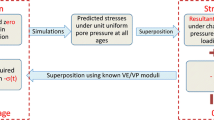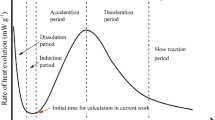Abstract
The development of computer models for cement hydration and microstructure development, with an explicit consideration of microstructure, has accelerated in the past 25 years, creating a need for a set of critical experimental observations that can be used in evaluating the model predictions. During this same time period, there have been rapid advances in experimental techniques for quantifying both the hydration rates and the produced microstructures. This paper utilizes several of these techniques to elaborate a preliminary set of experimental observations concerning the influence of water-to-cement ratio, cement particle size distribution, and curing conditions on hydration and microstructure development. Isothermal calorimetry provides a convenient measure of the ongoing hydration rates during the first 7 days of hydration, while low temperature calorimetry can be used to directly assess the percolation state of the capillary porosity and the quantity of freezable water in a hydrated cement paste. Conventional measurements of setting times, such as Vicat needle penetration, are related to the ongoing percolation transitions of the solids within the three-dimensional microstructure. Finally, since concretes in the field rarely experience saturated curing conditions, the influence of sealed curing on resultant degree of hydration and microstructure is examined. The presented data sets should provide a first step in performing a critical evaluation of existing and future computer models.








Similar content being viewed by others
References
Bentz, D.P.: CEMHYD3D: a three-dimensional cement hydration and microstructure development modeling package. Version 3.0. NISTIR 7232, US Department of Commerce, June 2005
Bishnoi, S., Scrivener, K.L.: μic: a new platform for modelling the hydration of cement. Cem. Concr. Res. 39(4), 266–274 (2009)
Bullard, J.W.: A determination of hydration mechanisms for tricalcium silicate using a kinetic cellular automaton model. J. Amer. Ceram. Soc. 91(7), 2088–2097 (2008)
Bullard, J.W., Enjolras, E., George, W.L., Satterfield, S.G., Terrill, J.E.: A parallel reaction-transport model applied to cement hydration and microstructure development. Modelling Simul. Mater. Sci. Eng. (2010). doi:10.1008/0965-0393/18/2/025007
Chen, W.: Hydration of slag cement—Theory, modeling, and application. Ph.D. Thesis, p. 223. University of Twente, The Netherlands (2006)
Maekawa, K., Chaube, R., Kishi, T.: Modelling of concrete performance: hydration, microstructure formation and mass transport. E&FN Spon, London (1999)
Van Breugel, K.: Simulation of hydration and formation of structure in hardening cement-based materials. Ph.D. Thesis, p. 295. Delft University, The Netherlands (1991)
Van Eijk, R.: Hydration of cement mixtures containing contaminants. Ph.D. Thesis, p. 200. University of Twente, The Netherlands (2001)
Diamond, S.: An “Unmodel” of portland cement hydration. 2nd International conference on advances in concrete through science and engineering. Quebec, Sept 2006
ASTM International, ASTM Standards on Disc, vol. 04.01 Cement; Lime; Gypsum, ASTM International (2007)
Cost, V.T., Gardiner, A.: Practical concrete mixture evaluation via semi-adiabatic calorimetry. NRMCA Technology Forum, pp. 21 (2009)
Bentz, D.P.: Verification, validation, and variability of virtual standards. In: Proceedings of the 12th international congress on the chemistry of cement, Montreal (2007)
Princigallo, A., Lura, P., van Breugel, K., Levita, G.: Early development of properties in a cement paste: a numerical and experimental study. Cem. Concr. Res. 33, 1013–1020 (2003)
Bentz, D.P.: Cement hydration: building bridges and dams at the microstructure level. Mater. Struct. 40(4), 397–404 (2007)
Sant, G., Ferraris, C.F., Weiss, J.: Rheological properties of cement pastes: a discussion of structure formation and mechanical property development. Cem. Concr. Res. 38(11), 1286–1296 (2008)
Robeyst, N.: Monitoring setting and microstructure development in fresh concrete with the ultrasonic through-transmission method. Ph.D. Thesis, p. 251. Ghent University, Belgium (2009)
Stefan, L., Benboudjema, F., Torrenti, J.-M., Bissonnette, B.: Prediction of elastic properties of cement pastes at early ages. Computational Mater. Sci. 47, 775–784 (2010)
Sayers, C.M., Grenfell, R.L.: Ultrasonic propagation through hydrating cements. Ultrasonics 31, 147–153 (1993)
Powers, T.C., Copeland, L.E., Mann, H.M.: Capillary continuity or discontinuity in cement paste. PCA Bulletin 10, 2–12 (1959)
Bentz, D.P., Garboczi, E.J.: Percolation of phases in a three-dimensional cement paste microstructural model. Cem. Concr. Res. 21, 324–344 (1991)
Bentz, D.P.: Capillary porosity depercolation/repercolation in hydrating cement pastes via low temperature calorimetry measurements and CEMHYD3D modeling. J. Amer. Ceram. Soc. 89(8), 2606–2611 (2006)
Sun, Z., Scherer, G.W.: Pore size and shape in mortar by thermoporometry. Cem. Concr. Res. 40(5), 740–751 (2010)
Snyder, K.A., Bentz, D.P.: Suspended hydration and loss of freezable water in cement pastes exposed to 90% relative humidity. Cem. Concr. Res. 34(11), 2045–2056 (2004)
Bentz, D.P.: Three-dimensional computer simulation of cement hydration and microstructure development. J. Amer. Ceram. Soc. 80(1), 3–21 (1997)
Bentz, D.P., Sant, G., Weiss, W.J.: Early-age properties of cement-based materials: I. Influence of cement fineness. ASCE J. Mater. Civ. Eng. 20(7), 502–508 (2008)
Lura, P., Winnefeld, F., Klemm, S.: A method for simultaneous measurements of heat of hydration and chemical shrinkage of hardening cement pastes. J. Therm. Anal. Calorim. (2010). doi:10.1007/s10973-009-0586-2
Geiker, M.R.: Studies of portland cement hydration: Measurements of chemical shrinkage and a systematic evaluation of hydration curves by means of the dispersion model. Ph.D. Thesis, Technical University of Denmark, Lyngby, Denmark (1983)
Sant, G.: Fundamental investigations related to the mitigation of volume changes in cement-based materials at early ages. Ph.D. Thesis, Purdue University, West Lafayette, IN (2009)
Bentz, D.P., Mizell, S., Satterfield, S., Devaney, J., George, W., Ketcham, P., Graham, J., Porterfield, J., Quenard, D., Vallee, F., Sallee, H., Boller, E., Baruchel, J.: The visible cement data set. NIST J. Res. 107(2), 137–148 (2002)
Féret, R.: Etudes sur la constitution intime des mortiers hydrauliques. Bulletin de la Société d’Encouragement pour Industrie Nationale, 5th series 2, 1591–1625 (1897)
Abrams, D.: Design of concrete mixtures. Structural Materials Research Laboratory, Bulletin No. 1, PCA LS001 (1918) http://www.cement.org/pdf_files/LS001.pdf
Bentz, D.P., Peltz, M.A., Winpigler, J.: Early-age properties of cement-based materials: II. Influence of water-to-cement ratio. ASCE J. Mater. Civ. Eng. 21(9), 512–517 (2009)
Sandberg, P.J., Roberts, L.R.: Cement-admixture interactions related to aluminate control. J. ASTM Inter. 2(6), 1–14 (2005)
Bentz, D.P., Aitcin, P.C.: The hidden meaning of water-to-cement ratio. Concr. Inter. 30(5), 51–54 (2008)
Bentz, D.P.: Blending different fineness cements to engineer the properties of cement-based materials. Mag. Concr. Res. 62(5), 327–338 (2010)
Bentz, D.P., Garboczi, E.J., Haecker, C.J., Jensen, O.M.: Effects of cement particle size distribution on performance properties of cement-based materials. Cem. Concr. Res. 29(10), 1663–1671 (1999)
Bentz, D.P., Lura, P., Roberts, J.W.: Mixture proportioning for internal curing. Concr. Inter. 27(2), 35–40 (2005)
Ye, G., Van Breugel, K., Fraaij, A.L.A.: Three-dimensional microstructure analysis of numerically simulated cementitious materials. Cem. Concr. Res. 33, 215–222 (2003)
Ye, G.: Percolation of capillary pores in hardening cement pastes. Cem. Concr. Res. 35, 167–176 (2005)
Bentz, D.P., Stutzman, P.E.: Curing, hydration, and microstructure of cement paste. ACI Mater. J. 103(5), 348–356 (2006)
Rajayogan, V.: Autogenous shrinkage in cementitious systems. Ph.D. Thesis, p. 390. The University of New South Wales, Australia (2009)
Kjellsen, K.O., Detwiler, R.J., Gjorv, O.E.: Backscattered electron imaging of cement pastes hydrated at different temperatures. Cem. Concr. Res. 20, 308–311 (1990)
Acknowledgments
The author would like to thank Mr. John Winpigler and Mr. Max Peltz of the Engineering Laboratory at NIST for their assistance in generating a portion of the data presented in this paper.
Author information
Authors and Affiliations
Corresponding author
Rights and permissions
About this article
Cite this article
Bentz, D.P. Critical observations for the evaluation of cement hydration models. Int J Adv Eng Sci Appl Math 2, 75–82 (2010). https://doi.org/10.1007/s12572-010-0017-4
Published:
Issue Date:
DOI: https://doi.org/10.1007/s12572-010-0017-4




